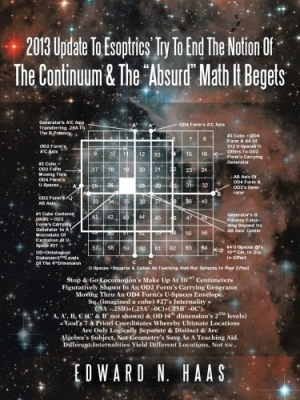2013 Update to Esoptrics' Try to End the Notion of the Continuum & the "Absurd" Math It Begets
The author’s colorful, distinct voice comes through loud and clear in this attempt to marry science and theology.
2013 Update to Esoptrics’ Try to End the Notion of the Continuum & the “Absurd“ Math It Begets, by Edward N. Haas, attempts to use mathematics, philosophy, and theology to explain what the universe looked like prior to the big bang. To this end, it puts forth the theory that the laws of the universe aren’t observable by human senses, rather sustained directly by the will of God. Quirky, unique, and full of personality, this book is best approached as theological philosophy rather than as science. Though it deals with theoretical physics, it draws more heavily from Catholic doctrine and the philosophical conclusions of the author than mainstream physics research. It also bears some conceptual similarity to the work of seventeenth-century philosopher Gottfried Wilhelm von Leibniz.
The book tends to declare math and physics rules arbitrarily—possibly because it promotes that introspection, not observation, is the correct way to determine the nature of reality. That said, it’s hard to understand how the book arrived at many of its conclusions. The choice of the number two as the basis for understanding all reality is never well explained, for example. Other concepts, such as the presence of a black hole inside of the sun, have no support in research or theology. It’s hard to imagine how other philosophers (or scientists) would be able to respond to these ideas if they are sourced only in the author’s personal beliefs.
Instead of a traditional bibliography, the back matter includes an “Index of Quotes” that includes author names, quote locations, and the context of the quotes within this text. The book tends to accompany quotations with an exuberant agreement or reply. One example:
“Guess what, Mr. Freedman! I dare suggest to you quite confidently that, with Esoptrics, that clue [to the ultimate laws of the universe] has now burst upon the world most thunderously.”
This colorful reaction fits well with the personality of the rest of the text, but its location, tacked onto a quote presented independently at the end of a chapter, is structurally odd. There seems to be no reason for its presence except as a means for a reply to the person being quoted. Though there are many instances of this, it is not as serious a flaw as the rare in-text citations, which usually don’t include page numbers and dates. The book also cites Wikipedia on a number of occasions, a source considered verboten for most research-based texts, and uses a limited number of general sources otherwise. Few of the specific facts used here are cited, even significant data points like distances between planets and the rate of Earth’s rotation.
Haas’s style is baroque and not boring, strung with metaphors and lively turns of phrase. Some initial abrasiveness, mostly the result of the book’s early self-aggrandizing, wanes as the text continues and eventually becomes a minor side issue. However, there is an abundance of technical terminology, much of it invented by Haas, and the glossary (called “Index of Topics”) is convoluted and heavily cross-referenced. Wading through is possible, but arduous.
Both the front and the back cover are unusually wordy. The cover image, a complicated matrix with accompanying explanations, is a very confusing introduction to the subject matter and potentially a poor introduction for scholars unfamiliar with Esoptrics.
While dense and strange, 2013 Update... has plenty of character thanks to the author’s distinct voice.
Reviewed by
Anna Call
Disclosure: This article is not an endorsement, but a review. The publisher of this book provided free copies of the book and paid a small fee to have their book reviewed by a professional reviewer. Foreword Reviews and Clarion Reviews make no guarantee that the publisher will receive a positive review. Foreword Magazine, Inc. is disclosing this in accordance with the Federal Trade Commission’s 16 CFR, Part 255.

